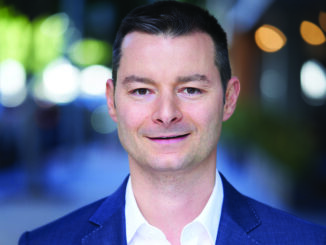by Nick Chiarelli, Engagement Lead, Trends and Futures Team, Ipsos, London, U.K.
Surrounded by Problems
It was arguably one of the most famous images of 2021.
Tuvalu’s foreign minister, Simon Kofe, recorded a speech for the United Nations COP26 climate conference in Glasgow standing knee-deep in seawater. The idea was to highlight how his low-lying Pacific Island nation is on the front line of climate change, and it worked. The images of Kofe standing in a suit and tie at a lectern set up in the sea were shared widely on social media and focused attention on a profound problem facing not just Tuvalu but all of us.

Sadly, climate change is but one of the problems facing the world over the next few years. The United Nations (U.N.) currently lists twenty-two “Global Issues,” and, even then, they point out that this is not intended to be an exhaustive list but, instead, just an overview of some of the major issues all global citizens should be aware of.1 Climate change, air pollution, COVID-19, Brexit, resource depletion, constrained global supply chains, growing inequality, and on and on.
Looking at one particular challenge—natural disasters—can help us to see how understanding the issue can help rally efforts to bring about change. The U.N. Office for Disaster Risk Reduction estimates that natural disasters are happening three times as often as fifty years ago.2 The numbers of reported natural disasters, people affected, and the economic impacts they have are all much higher than twenty years ago. However, they also say: “It is time to recognize that there is no such thing as a ‘natural disaster’ and we should stop using that term—we are doing it to ourselves.” We are all part of the problem.
Problems Demand Solutions
If we are all part of the problem, we can (and should) be part of the solution. Brands are not exempt from this responsibility—as the quote originally attributed to American writer Eldridge Cleaver has it, “If you are not part of the solution, you must be part of the problem.”
Over recent months, there has been considerable debate about brand purpose in the marketing community. As is the case with so many issues today, two sharply divided camps have emerged. Some believe that the only way brands can build strong relationships with consumers is by doing more than just making and selling stuff. Others believe that, right now, they should just focus on making products that help people to live their lives and sell them at a reasonable price. Terry Smith of the Fundsmith Equity Fund is perhaps a flagbearer for this latter sentiment, recently calling out Unilever for prioritizing sustainability “at the expense of focusing on the fundamentals of the business.”3
Data from the 2021 wave of Ipsos’ Global Trends Survey (which collected data from 25,000 respondents in twenty-five countries) suggests that the public across twenty-five markets around the world does want brands to get involved:4
- Seventy percent globally agree that “business leaders have a responsibility to speak out on social and political issues affecting my country.”
- Seventy percent globally agree that “I tend to buy brands that reflect my personal values.” This feeling was already growing pre-COVID, having risen from 43 percent in the U.K. in 2013 to 56 percent in 2019, but it has continued to rise during COVID, now standing at 60 percent.
Even more compelling is the assertion that brand purpose can increase revenue:
- Fifty-five percent globally agree that “I am generally willing to spend extra for a brand with an image that appeals to me.”
We can also see the counter view in our data:
- Forty-five percent globally (including 47 percent of those in the U.S. and 41 percent of those in the U.K. and Germany) agree that “I don’t care if a brand is ethically or socially responsible, I just want them to make good products.”
We’ve seen lots of problems created in 2020 and 2021, and there are lots of opportunities for brands to be part of the solution to those problems. While the challenging economy means many are simply looking for good, fairly priced products, there is also a clear demand that brands do more, no longer being content to merely observe what is going on in society, but to comment on how it should be improved and then to act.
Looking for Solutions
The first step in acting is understanding what the problems are, seeing how important they are to the people you are looking to serve, how likely they are to remain problematic, and gaining inspiration from how others are starting to offer solutions to those problems. Our Global Trends Survey for 2021 highlighted five major areas of opportunity:
Problem 1: Lessening divisions in society (or, at least, the impact of those divisions)
There’s a lot of talk about how divided societies have become with gender divisions, high income inequality with the haves and the have-nots, political and ideological divisions between the right and left growing ever more deeply entrenched, and passions running high among both vaxxers and antivaxxers.
Our evidence suggests that most people feel unity rather than division—73 percent agree that “people across the world have more things in common than things that make them different.” But it’s also true that inequalities and divisions persist: The pandemic may have lessened the differences between countries because of its outsized effects on the economies of more developed nations, but it has increased inequality within countries. The divisions between those directly affected by the economic fallout of the pandemic and those continuing to work and earn as pre-COVID are now significant differentiating factors for understanding consumer behaviour and must be considered alongside traditional “breaks” like age, gender, income, etc. The global public agrees: 74 percent agree that “Having large differences in income and wealth is bad for society overall,” and they also feel that the differences remain:
- Eighty-one percent agree that “In my country, there is more and more conflict between people who don’t share the same values.”
- Seventy-two percent think racism is very/somewhat present in their country.
Addressing division offers a worthwhile platform for brands, and there is no shortage of examples of brands seeking to demonstrate their empathy with the concerns of marginalised groups in our societies. This is admirable enough, but tangible support can make more of a difference. For example, following the Black Lives Matter movement, U.S.-based beauty product search engine Mira created a dedicated marketplace on its platform for customers to shop Black-owned businesses.
Problem 2: Resetting sustainability efforts
It is time to reset our priority on sustainability. While consumers have continued to be concerned by it during COVID, policy makers and nongovernment organizations (NGOs) were more focused on dealing with the health crisis and prevented from action (e.g., protests or environmental initiatives) by the restrictions of lockdown. Eighty-four percent of global consumers agree that “We are heading for environmental disaster unless we change our habits quickly,” which is up from 73 percent in 2013.
Many brands have taken their first steps toward being more sustainable, but the onus is now on them to do more: walk the walk to go with the pretty words, go beyond their Net Zero pledges, accelerate their deadlines. More than this, they must resist the temptation to waste resources telling consumers about all the “great work” they’ve done and use the money saved to start on the next round of efforts.
Problem 3: Rebalancing peoples’ relationship with global and local
There has long been a paradox when it comes to globalization: most feel it is a good thing, but there is also a real concern about the way it can undermine our sense of local culture and community. Emerging markets like China show the most favorable reactions toward globalization, and old-world countries such as France are the most negative. But, at the same time, there is also a real appreciation of the power of local in the form of our communities, and as sources for products that may better suit our tastes or be more sustainable:
- Seventy-eight percent agree that “My local area is a place where people from different backgrounds get on well together.”
- Fifty-nine percent agree that “I prefer to buy products from my country rather than products from abroad.”
If anything, COVID seems to have further nuanced the debate. On the one hand, 67 percent now agree that “Globalization is good for my country,” a figure that is rising everywhere—even in France! Yet, at the same time, lockdown has kept us in our local communities and given us new opportunities to appreciate our local areas, support local businesses, and strengthen ties with neighbors and neighborhoods.
As we begin to put COVID behind us, it is likely that consumer attention will start to look further afield for many of those cultural experiences that they feel they have been deprived of over the past couple of years. However, it is also likely that they will want to maintain some of the local warmth, comfort, and convenience as hybrid working seems to be the new work normal rather than a full-scale return to offices and city centers.
Even the most global of brands can recognise and empower local communities. Burger King allocated its Instagram account (see https://bit.ly/3GtBCk7) to local restaurants that were struggling in the darkest days of lockdown; brands should look for opportunities to bolster local businesses as well as recognise their own place within those communities.
Problem 4: Enabling healthier living
While we’ve been battling with a health crisis worse than any in living memory, people have also been very aware of other broader health challenges. People recognise that they need to do more to look after themselves physically and say they would like more control over decisions about their health.
COVID itself, and the changes in lifestyle that it has forced on us all, has also sharpened and polarized the issue. Globally, three-quarters report changes to their weight, exercise, alcohol consumption, or smoking since the pandemic began. Almost one-third (31 percent) of the global population have gained weight despite a clear link between obesity and suffering from more severe symptoms of COVID-19.
Health is not just an issue about food and beverage brands and/or those in the exercise market. Brands must recognise the increasing focus on the link between planetary health and individual well-being. They should pick an area of focus, whether it be mental health or obesity (which are the current health supervillains), and offer practical solutions for their employees as well as their customers.
Problem 5: Reclaiming the future
When the world of today is unrelentingly grim, people have two psychological routes. First, they can try to think ahead to when times will get better; or, conversely, they can look back to when times (in their minds at least) were better—the so-called glow of rosy retrospection.
Given the uncertain economic future, climate change being a decades-long challenge, and the pathway out of COVID still to be determined, looking ahead to the future with real optimism is hard. No wonder then that the past seems more appealing to some. When asked, “Given the choice, I would prefer to have grown up at the time when my parents were children,” there is perfect global balance between the pro and con: 46 percent agree, 46 percent disagree.
But such global balance is an illusion. Take the U.K. data, for example: While only 19 percent of baby boomers (born 1946–1965) would have preferred to grow up in the time that their parents did, some 47 percent of Gen Z (born 1996–2010) feel this way. Only 25 percent of U.K. Gen Zers feel that “my generation will have (or have had) a better life than their parents,” while 52 percent of boomers feel this way. While objective measures suggest life today is as good as it has ever been, young people clearly don’t feel this way, and there is a real sense of a lost future.
It is vital for all of us that young people can find a sense of hope to galvanise their energy and creativity to the issues they will face. For their part, brands must focus their efforts on helping to build this sense of hope, as well as enabling young people to plan ahead in a time of profound uncertainty.
Picking the Right Problem for Your Brand
Investing in brand purpose doesn’t come cheap. Of course, brands need to go beyond the headline global numbers and themes discussed here to understand the particular problems and solutions that are relevant in their country, for their specific target audiences, and that are appropriate for their brand.
Some of the themes identified above represent opportunity areas for brands. However, they also give pointers to the research industry for how to best gather the insights that brands will need to tap opportunity areas that are both appropriate for their target audience and most beneficial to the brand.
Sample Design: The divided nature of society, for example, makes it even more crucial than ever to give proper attention to sample design, ensuring that your research design is fully inclusive and gives participants the ability to engage with your research process as their truly authentic selves.
Inclusive Design: Research processes also need to be as friction-free as possible so that the barrier to accessing the study (downloading the right app and getting through login) ensures we don’t introduce a bias into our research processes and insight generation.
Every Crisis Is an Opportunity
Societies, and the consumers that live in them, just want to get on with life. Anything that can deal with the problems we encounter, both big and small, is appreciated.
Brands can and should be part of the solution. Passivity is no longer an option. It is no longer enough to try to focus on doing as little harm as possible. The time has come to flick the switch and for brands to use their engagement with consumers as platforms for good. However, brands looking to build their credentials in this space must on no account take their eye off the day-to-day ball. Stretching themselves into purpose-laden territory cannot come at the expense of any compromises on product and service quality. Consumers have given themselves the right to be unreasonably demanding; they want it all from brands—purpose and product quality; societal contributions and value for money; empathy on the big issues and an appreciation of consumers’ everyday lives and challenges. It is a big ask, and only the best will be up to it.
The research industry has a vital role to play in helping brands pick the right issues to focus on and develop the appropriate responses. Crucially, research also helps ensure that those responses remain grounded in consumer truth and provide brands with actionable insight for good, but only when it is designed to pick up on the nuances rather than the surface numbers. Qualitative and ethnographic research techniques can ensure that brands get a proper understanding of why and how they expect brands to act, not just which issues tick their boxes.
Brands need to be part of the solution, and the research industry needs to be the power behind those solutions.
References:
- www.un.org/en/global-issues
- www.latimes.com/world-nation/story/2021-09-01/weather-disasters-more-numerous-costly-climate-change
- www.thedrum.com/news/2022/01/13/marketers-clash-whether-unilever-has-lost-the-plot-over-brand-purpose
- www.ipsos.com/en-uk/ipsos-global-trends-2021-report-aftershocks-and-continuityThe 2021 report from the Ipsos Global Trends Survey is available for download at: www.ipsos.com/en/global-trends-2021-aftershocks-and-continuity




Be the first to comment